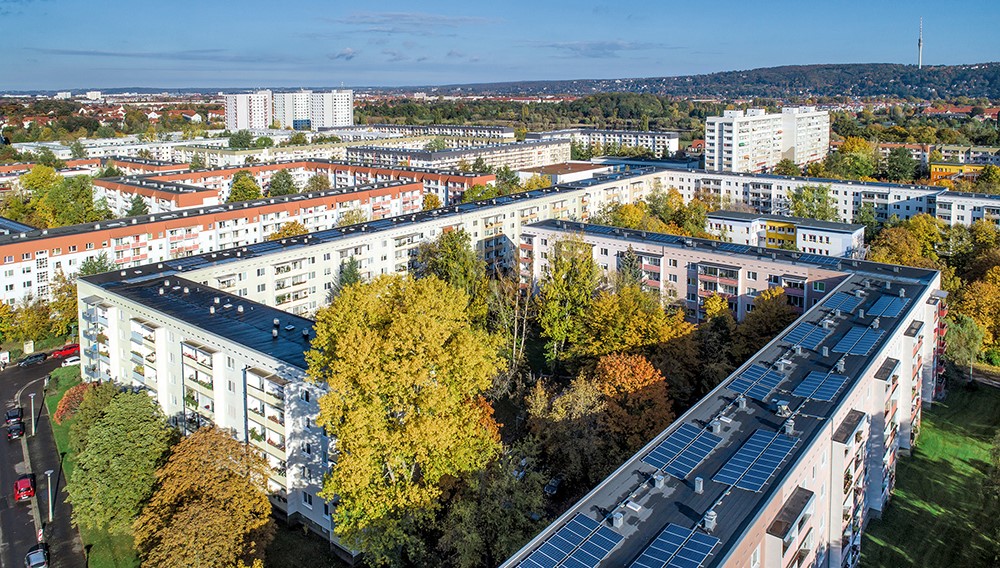Forecast Report
Business Outlook
Comparison of the Previous Forecasts With the Results From 2021
All in all, the 2021 fiscal year was very successful for Vonovia despite the ongoing coronavirus pandemic. By continuing with our crisis management approach, we were able to successfully meet the challenges posed by the coronavirus crisis. Segment revenue increased in all of our operating segments.
In addition, we used the successful takeover and acquisition of a majority stake in Deutsche Wohnen to further enhance our market position. Deutsche Wohnen was consolidated for the first time as of September 30, 2021, meaning that all opportunities and risks associated with the Deutsche Wohnen Group have also passed to Vonovia. The integration process has been launched successfully. The Deutsche Wohnen segment is included in the earnings contributions for the fourth quarter of 2021 for the first time. The Deutsche Wohnen integration process will potentially involve making decisions on a new segment structure in the 2022 fiscal year.
The coronavirus pandemic had no noteworthy impact on the Rental segment. In the Value-add segment, our modernization activities were only restricted to a slight degree by the coronavirus crisis. In the Recurring Sales segment, there were a few isolated delays in apartment viewings. The Development segment performed well thanks to successful project developments and completions. The total segment revenue came to around € 5.2 billion (incl. Deutsche Wohnen) in 2021, up by 18.5% on the prior-year figure of around € 4.4 billion. Excluding Deutsche Wohnen, total segment revenue came to around € 4.9 billion in 2021, up by around 11% on the prior-year figure, putting it at the lower end of the most recent forecast range of between € 4.9–5.1 billion.
Adjusted EBITDA Total rose by 18.8% from € 1,909.8 million to € 2,269.3 million (incl. Deutsche Wohnen). Excluding Deutsche Wohnen, Adjusted EBITDA came to € 2,098.5 million. The latest forecast range was between € 2,055 million and € 2,105 million. With the exception of the Value-add segment, all other segments reported growth in Adjusted EBITDA. The increase in adjusted EBITDA Rental was driven primarily by organic growth resulting from new construction and modernization measures. In addition, Adjusted EBITDA in the Development segment rose from € 110.9 million in 2020 to € 187.7 million in 2021, primarily due to the global exit of a “Development to sell” project. Group FFO rose by 24.0% from € 1,348.2 million in 2020 to € 1,672.0 million in 2021 (incl. Deutsche Wohnen). Excluding Deutsche Wohnen, Group FFO came to € 1,534.5million, falling within the most recent forecast range of between € 1,520 million and € 1,540 million.
The EPRA NTA per share came in at € 66.73 in 2021, up by 13.5% on the TERP-adjusted prior-year value of € 58.78. This includes effects from fair value adjustments of investment properties in the amount of € 7.4 billion in total (2020: € 3.7 billion). The distribution of the cash dividend of € 486.0 million in 2021 had the opposite effect (2020: € 504.6 million). Excluding further market-related changes in value, the EPRA NTA per share was originally expected to increase moderately. From Vonovia’s perspective, it is not possible to arrive at a valid forecast of market-related changes in value, which is why no EPRA NTA per share including market-related changes in value was forecast for 2021 (and the figure is not being forecast for 2022 either) and there will be no comparison with the value achieved in 2021.
In 2021, our Sustainability Performance Index (excluding Deutsche Wohnen) came to 109%, higher than our most recent forecast of 105% and the original forecast of around 100%. This was helped along in particular by the reduction of CO₂ intensity, the development of the average primary energy requirements of new construction, and the positive development of the customer satisfaction index.
Forecast for the 2022 Fiscal Year
Our forecast for the 2022 fiscal year is based on determined and updated corporate planning for the Vonovia Group as a whole, and considers current business developments, the acquisition of Deutsche Wohnen, possible opportunities and risks, and the expected impacts of the coronavirus pandemic. It also includes the key overall macroeconomic developments and the economic factors that are relevant to the real estate industry and our corporate strategy. Further information is provided in the sections entitled Development of the Economy and the Industry and Fundamental Information About the Group. Beyond this, the Group’s further development remains exposed to general opportunities and risks (see chapter on Opportunities and Risks).
The forecast was based on the accounting principles used in the consolidated financial statements, with the adjustments described elsewhere in the management report being made. The forecast does not take account of any larger acquisitions of real estate portfolios.
We continue to expect that the coronavirus pandemic will not have a significant impact on the key operational and financial figures of any of the operating segments and therefore will have no noteworthy impact on future business development. We are currently observing stable demand for rental apartments and no negative impact on market values as a result of the coronavirus pandemic.
We expect total segment revenue to increase further in 2022. We also expect to see a marked increase in Adjusted EBITDA Total, with the Deutsche Wohnen operating segment contributing the biggest increase in absolute terms in 2022 (compared to the Q4 contribution in 2021) as it will be making a contribution for a full year. The EBITDA contribution for the Rental segment is expected to be on par with the previous year’s level. We predict weak growth for Value-add and Recurring Sales. Given the strong result in the 2021 fiscal year, mainly due to a major global exit of a “Development to sell” project, we expect to see a slight decline in the Development segment. We also expect to see a marked increase in Group FFO. In addition, we expect the value of our company to increase further in 2022 and predict a slight increase in EPRA NTA per share, leaving any further market-related changes in value out of the equation.
Based on the individual weighted targets and the values planned for the 2022 fiscal year in each case, we predict a total value of around 100% for the Sustainability Performance Index (excluding Deutsche Wohnen).
The table below provides an overview of the development of our forecast performance indicators excluding Deutsche Wohnen, their target achievement level in the 2021 fiscal year, the Group figures for 2021 as well as a forecast for the 2022 fiscal year.
Development of forecast performance indicators incl. target achievement level
Actual 2020 | Forecast for 2021 | Forecast for 2021 in the 2021 Q3 Report*** | Actual 2021*** | Actual 2021 | Forecast for 2022 | |||||||
Total Segment Revenue | € 4.4 billion | € 4.9–5.1 billion | € 4.9–5.1 billion | € 4.9 billion | € 5.2 billion | € 6.2–6.4 billion | ||||||
Adjusted EBITDA Total | € 1,909.8 million | € 1,975–2,025 million | Around upper end of € 2,055–2,105 million | € 2,098.5 million | €2,269.3 million | € 2.75–2.85 billion | ||||||
Group FFO* | € 1,348.2 million | € 1,415–1,465 million | € 1,520–1,540 million | € 1,534.5 million | € 1,672.0 million | € 2.0–2.1 billion | ||||||
Group FFO per share** | € 2.23 | suspended | suspended | € 1.98 | € 2.15 | suspended | ||||||
EPRA NTA per share** | € 58.78 | suspended | suspended | – | € 66.73 | suspended | ||||||
Sustainability Performance Index (SPI)*** | – | ~100% | ~105% | 109% | – | ~100% | ||||||
Rental income rental Segment/Deutsche Wohnen | € 2,285.9 million | € 2.3–2.4 billion | € 2.3–2.4 billion | € 2,361.6 million | € 2,568,7 million | € 3.1–3.2 billion | ||||||
Organic rent growth (eop) | 3.1% | Increase of ~3.0–3.8%**** | Increase of ~3.8% | 3.8% | 3.8% | Increase of ~3.3% | ||||||
Modernization and new construction | € 1,343.9 million | € 1.3–1.6 billion | € 1.3–1.6 billion | € 1,285.2 million | € 1,398.3 million | € 2.1–2.5 billion | ||||||
Number of units sold Recurring Sales/Deutsche Wohnen core | 2.442 | ~2,500 | ~2,800 | 2.747 | 2.748 | ~3,000 | ||||||
Fair value step-up Recurring Sales/Deutsche Wohnen core | 39.6% | ~30% | >35% | 38.8% | 38.8% | ~30% | ||||||
- *Comparable Group FFO 2021 based on a new definition for 2022 without elimination of IFRS 16 effect: € 1,709.3 million.
- **Based on the shares carrying dividend rights on the reporting date, prior-year value TERP-adjusted (1.067), excluding real estate transfer tax and taking into account the total deferred taxes on investment properties of Deutsche Wohnen in the amount of € 5,880 million (previously only 50% included), this results in an EPRA NTA per share 2021 of € 62.77.
- ***Excluding Deutsche Wohnen.
- ****Depending on whether or not the Act on Rent Controls in the Housing Sector in Berlin (MietenWoG Bln) is found to be constitutional at the end of 2021, we expect rent increases at the upper/lower end of the forecast.
Bochum, Germany, March 10, 2022
The Management Board
Rolf Buch
(CEO)
Arnd Fittkau
(CRO)
Philip Grosse
(CFO)
Daniel Riedl
(CDO)
Helene von Roeder
(CTO)



